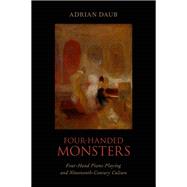Four-Handed Monsters Four-Hand Piano Playing and Nineteenth-Century Culture

Four-Handed Monsters Four-Hand Piano Playing and Nineteenth-Century Culture
- ISBN 13:
9780199981779
- ISBN 10:
0199981779
- Format: Hardcover
- Copyright: 06/02/2014
- Publisher: Oxford University Press
.svg) Rent
From $31.77
Rent
From $31.77
List Price $45.85 Save
| TERM | PRICE | DUE |
|---|---|---|



List Price $45.85 Save $0.46
Usually Ships in 3-5 Business Days
We Buy This Book Back!
Free Shipping On Every Order
Note: Supplemental materials are not guaranteed with Rental or Used book purchases.
Extend or Purchase Your Rental at Any Time
Need to keep your rental past your due date? At any time before your due date you can extend or purchase your rental through your account.
Summary
Four-hand piano playing was often understood as a socially acceptable way of flirting, a flurry of hands that made touching, often of men and women, not just acceptable but necessary. But it also became something far more serious than that, a central institution of the home, mediating between inside and outside, family and society, labor and leisure, nature and nurture. And writers, composers, musicians, philosophers, journalists, pamphleteers and painters took note: in the art, literature, and philosophy of the age, four-hand playing emerged as a common motif, something that allowed them to interrogate the very nature of the self, the family, the community and the state. In the four hands rushing up and down the same keyboard the nineteenth century espied, or thought to espy, an astonishing array of things. Four-Handed Monsters tells not only the story of that practice, but also the story of the astonishing array of things the nineteenth century read into it.






